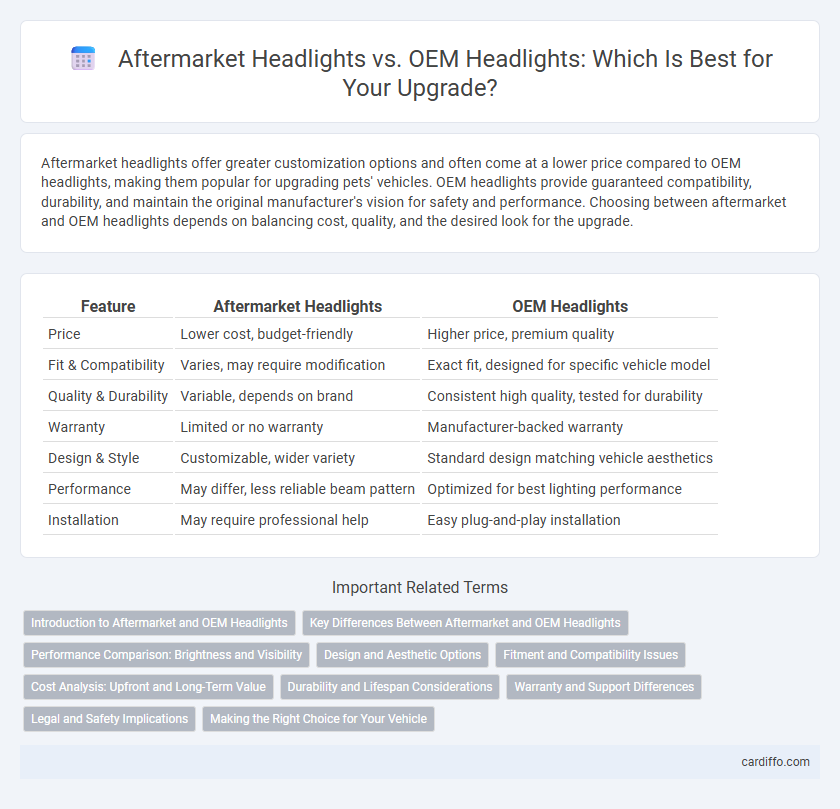Aftermarket headlights offer greater customization options and often come at a lower price compared to OEM headlights, making them popular for upgrading pets' vehicles. OEM headlights provide guaranteed compatibility, durability, and maintain the original manufacturer's vision for safety and performance. Choosing between aftermarket and OEM headlights depends on balancing cost, quality, and the desired look for the upgrade.
Table of Comparison
| Feature | Aftermarket Headlights | OEM Headlights |
|---|---|---|
| Price | Lower cost, budget-friendly | Higher price, premium quality |
| Fit & Compatibility | Varies, may require modification | Exact fit, designed for specific vehicle model |
| Quality & Durability | Variable, depends on brand | Consistent high quality, tested for durability |
| Warranty | Limited or no warranty | Manufacturer-backed warranty |
| Design & Style | Customizable, wider variety | Standard design matching vehicle aesthetics |
| Performance | May differ, less reliable beam pattern | Optimized for best lighting performance |
| Installation | May require professional help | Easy plug-and-play installation |
Introduction to Aftermarket and OEM Headlights
Aftermarket headlights offer a wide range of styles and features designed to enhance vehicle appearance and performance, often at a lower cost than OEM headlights. OEM headlights are manufactured by the original vehicle maker, ensuring perfect fit, quality, and compliance with safety standards specific to the car model. Choosing between aftermarket and OEM headlights involves balancing customization options against guaranteed compatibility and reliability.
Key Differences Between Aftermarket and OEM Headlights
Aftermarket headlights offer a wider range of designs and typically cost less than OEM headlights, but OEM headlights guarantee exact fit, compatibility, and adherence to manufacturer quality standards. OEM headlights often come with warranties and meet strict safety regulations, ensuring optimal performance and durability, while aftermarket options vary in quality and may require modifications for installation. Choosing between aftermarket and OEM depends on balancing budget constraints, aesthetic preferences, and the importance of maintaining factory specifications.
Performance Comparison: Brightness and Visibility
Aftermarket headlights often offer higher brightness levels and customizable beam patterns, enhancing nighttime visibility and road safety. OEM headlights prioritize consistent light output and beam focus calibrated to vehicle specifications, ensuring optimal performance under standardized conditions. Comparing lumen output and beam spread, aftermarket options may exceed OEM standards but risk glare or uneven lighting if not properly installed.
Design and Aesthetic Options
Aftermarket headlights offer a wider range of design and aesthetic options, including customizable LED patterns, smoked lenses, and unique housing colors that OEM headlights typically lack. These enhancements allow vehicle owners to tailor their car's appearance to personal style preferences and stand out with modern, aggressive looks. OEM headlights prioritize standardized design for brand consistency and optimal factory performance but offer limited variation in style and customization.
Fitment and Compatibility Issues
Aftermarket headlights often offer a wider range of design options but may face fitment and compatibility issues due to variations in manufacturing standards. OEM headlights guarantee exact fitment and compatibility with specific vehicle models, ensuring seamless installation and optimal performance. Choosing OEM parts reduces the risk of wiring issues, alignment problems, and regulatory non-compliance that could arise with some aftermarket alternatives.
Cost Analysis: Upfront and Long-Term Value
Aftermarket headlights typically cost 30-50% less upfront compared to OEM headlights, offering budget-friendly options for vehicle upgrades. However, OEM headlights provide superior durability and performance, potentially reducing long-term replacement and maintenance expenses. Investing in OEM headlights can lead to better resale value and fewer compatibility issues, enhancing overall vehicle efficiency.
Durability and Lifespan Considerations
Aftermarket headlights often offer competitive pricing but may lack the stringent quality controls found in OEM headlights, leading to variable durability and shorter lifespan. OEM headlights are designed to meet exact manufacturer specifications, ensuring optimal performance and longer operational life under standard conditions. Prioritizing OEM headlights can result in sustained reliability and reduced replacement frequency due to superior materials and manufacturing standards.
Warranty and Support Differences
Aftermarket headlights often come with limited warranties ranging from 90 days to 1 year, while OEM headlights typically offer extended warranties aligned with the vehicle's overall coverage, enhancing consumer confidence. OEM headlights benefit from direct manufacturer support, ensuring proper fitment and compatibility, whereas aftermarket options may require additional installation expertise and lack consistent technical assistance. Choosing OEM headlights can reduce risks associated with defects and compatibility issues, supported by reliable customer service and warranty fulfillment.
Legal and Safety Implications
Aftermarket headlights often vary in compliance with federal and state regulations compared to OEM headlights, potentially affecting vehicle legality and insurance coverage. OEM headlights are designed to meet strict safety standards, ensuring optimal light output and beam pattern to reduce glare and enhance visibility. Choosing OEM headlights minimizes risks associated with non-compliant lighting that can lead to fines, failed inspections, or compromised road safety.
Making the Right Choice for Your Vehicle
Choosing Between Aftermarket Headlights and OEM Headlights hinges on factors like quality, compatibility, and cost. OEM headlights ensure exact fit and factory-quality performance, maintaining your vehicle's original specifications and warranty. Aftermarket headlights offer a wider variety of styles and often lower prices but may vary in build quality and require careful research to avoid compatibility issues.
Aftermarket Headlights vs OEM Headlights Infographic

 cardiffo.com
cardiffo.com